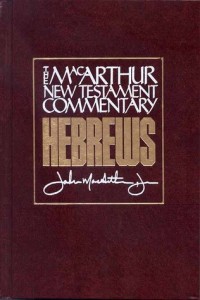Hebrews 9:6-10 MacArthur’s View
NAS Hebrews 9:1-10 Now even the first covenant had regulations of divine worship and the earthly sanctuary. 2 For there was a tabernacle prepared, the outer one, in which were the lampstand and the table and the sacred bread; this is called the holy place. 3 And behind the second veil, there was a tabernacle which is called the Holy of Holies, 4 having a golden altar of incense and the ark of the covenant covered on all sides with gold, in which was a golden jar holding the manna, and Aaron’s rod which budded, and the tables of the covenant. 5 And above it were the cherubim of glory overshadowing the mercy seat; but of these things we cannot now speak in detail. 6 Now when these things have been thus prepared, the priests are continually entering the outer tabernacle, performing the divine worship, 7 but into the second only the high priest enters, once a year, not without taking blood, which he offers for himself and for the sins of the people committed in ignorance. 8 The Holy Spirit is signifying this, that the way into the holy place has not yet been disclosed, while the outer tabernacle is still standing, 9 which is a symbol for the present time. Accordingly both gifts and sacrifices are offered which cannot make the worshiper perfect in conscience, 10 since they relate only to food and drink and various washings, regulations for the body imposed until a time of reformation.
MACARTHUR’S VIEW
UNLESS MY STUDY CHANGES MARKEDLY THROUGHOUT CHAPTERS 9 AND 10, I WILL MOST PROBABLY BE SINGLING OUT JOHN MACARTHUR’S COMMENTARY FOR SPECIAL EMPHASIS.
The central, in fact the only thing in the Holy of Holies was the ark, which represents Jesus Christ, the true mercy seat. When we meet Jesus Christ as Savior, we are ushered into the presence of God, into the true Holy of Holies. God no longer communes with men between the wings of cherubim on a gold mercy seat. He communes with men in His Son, by whom the veil was torn in two. Jesus Christ is the mercy seat. Only on the basis of the blood of a goat would God have fellowship with Israel, and only on the basis of the blood of Christ will God have fellowship with men. Joh, in using the term “propitiation in 1 John 2:2, relates Jesus to the mercy seat, since that very Greek word hilasterion is used for mercy seat in the Septuagint translation of Exodus 25:17.
The Old Covenant had a sanctuary with divine pictures and symbols, but it was earthly and temporary and it never provided true access to God.
THE OLD SERVICES
Now when these things have been thus prepared, the priests are continually entering the outer tabernacle, performing the divine worship, but into the second only the high priest enters once a year, not without taking blood, which he offers for himself and for the sins of the people committed in ignorance. (9”6-7)
In its sanctuary the Old Covenant had divine services. Every day the priests had to trim the wicks and add oil in the lampstand and put incense on the altar of incense. Every Sabbath they had to change the twelve loaves of bread. They were continually in and out of the Holy Place ministering on behalf of the people. Theirs was a never-ceasing work. In this they picture Jesus Christ, who does not cease enlightening and feeding and interceding on our behalf. This work of His is perpetual, continual, unceasing. How wonderful that our Lord never stops His priestly work for us. He is an ever-loving High Priest.
NOTHING HOWEVER, PICTURES CHRIST SO PERFECTLY AS THE WORK OF THE HIGH PRIEST IN THE HOLY OF HOLIES ON THE DAY OF ATONEMENT (YOM KIPPUR), VERY BRIEFLY SUMMARIZED IN VERSE 7…
ESV Hebrews 9:7 but into the second only the high priest goes, and he but once a year, and not without taking blood, which he offers for himself and for the unintentional sins of the people.
Whenever an Israelite sinned, his communion with God was broken. Consequently, the sacrifices for sin were never finished and the priests’ work was never done. In spite of the continual sacrificing, however, many unknown or forgotten sins would accumulate, for which no sacrifice had been made. The Day of Atonement was intended to make sacrifice for all those sins that had not yet been covered.
It was a great day for liberation of the conscience (see Lev. 16). The Israelite knew that whatever this may have been missed in the daily sacrifices would now be taken care of. The slate would be completely clean, at least symbolically for a while. Yom Kippur was a time of release and relief. The devout Jew longed for the Day of Atonement. He could not himself go into God’s presence, but the high priest would go in for him and he would be delivered.
Very early on the Day of Atonement, the high priest cleansed himself ritually and put on his elaborate roes, and the breastplate, near the heart, signifying that he carried the people in his heart) and ephod on the shoulder, signifying that he had power on their behalf) representing the twelve tribes. Then he began his daily sacrificing. Unlike Christ, he had to sacrifice for his own sin. Very likely he would have already slaughtered twenty-two different animals by the time he reached the event known as the atonement. It was an exceptionally busy and bloody thing that he on this day. After finishing all these sacrifices, he took off the robes of glory and beauty and went and bathed himself again completely. He then put on a white linen garment, with no decoration or ornament at all, and performed the sacrifice of atonement.
IN THIS RITUAL, THE HIGH PRIEST SYMBOLIZED JESUS CHRIST, WHO, IN HIS TRUE AND PERFECT WORK OF ATONEMENT, STRIPPED OF ALL HIS GLORY AND BEAUTY AND BECAME THE HUMBLEST OF THE HUMBLE. HE DRESSED HIM IN HUMAN FLESH, PURE AND PLAIN AND UNADORNED.
IN ALL OF HIS HUMILITY, HE NEVER LOST HIS HOLINESS.
When the high priest was done with the sacrifice of atonement, he put the robes of glory and beauty back on, picturing still further the work of our Lord. In His high priestly prayer, anticipating what would happen after the crucifixion and resurrection, Jesus said, “And now, glorify Thou Me together with Thyself, Father, with the glory which I had with Thee before the world was “ (John 17:5). HE WAS SAYING IF EFFECT, “GIVE ME BACK MY ROBES. I’VE DONE THE JOB OF ATONEMENT. MY WORK OF HUMILITY IS OVER.” – John MacArthur
Professor Thomas A. Rohm



